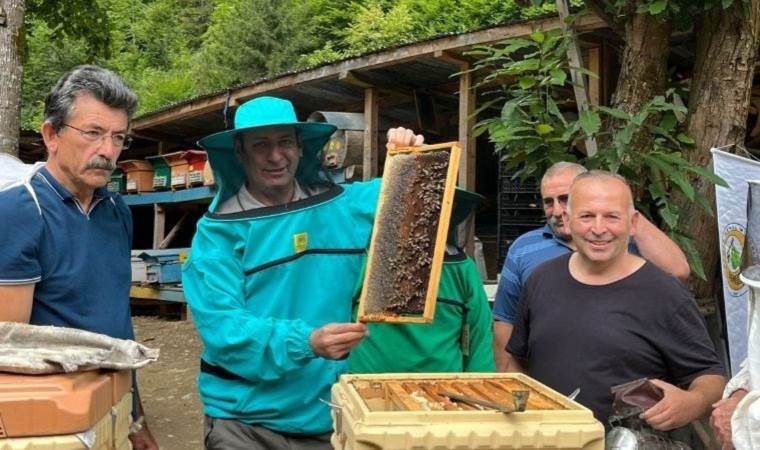After 25-years in journalism, man turned to beekeeping!
In Artvin, one of Turkey's richest regions with 2,727 plant species, the honey harvest has begun in Kokolet Valley, one of the 20 honey forests established by the Regional Forest Directorate. Beekeepers are very pleased with this year’s honey yield and quality.

The 20 honey forests, established by the Artvin Regional Forest Directorate to develop beekeeping and support organic honey production, have become a significant source of income for the local population. Beekeeping in Artvin, with its diverse flora, is conducted with great care.
The honey harvest has commenced in the honey forests located in Kokolet Valley, Murgul district. Honey produced by Caucasian bees was collected from the hives for extraction. The harvest event was attended by local residents, beekeepers, Özgür Balcı, Head of the Ecosystem Services Department of the Regional Forest Directorate, Regional Forest Director Mimar Sinan Özkaya, and Beekeepers Association President İbrahim Durmuş.
Durmuş highlighted that honey forests provide a crucial supplementary income for forest villagers, enhancing their living standards. He emphasized the significance of Kokolet Valley, saying, "When you think of Kokolet, think of honey. Murgul's Kokolet Valley is a rare gem. It has only one entry point, and there’s no agriculture or pesticide use here—it's left entirely to nature. Our quality honey is produced in this region. People come from Istanbul and Izmir to buy their honey here. Artvin's endemic plant diversity is present in Kokolet Valley. The presence of species like chestnut, blueberry, cherry laurel, linden, and mixed honey with forest rose ensures the prominence of this area. We thank our beekeepers for living in this wild nature and feeding the bees."
Former Journalist Turns Beekeeper
İlker Turhan, who practices beekeeping in Kokolet Valley, shared his experience: "In this valley, chestnut honey harvesting starts in the first week of August every year. The season went well, and we expect good results. We hope to see the fruits of our labor. Kokolet Valley has more endemic diversity compared to other valleys. The Caucasian bee has a range of 8 kilometers, affecting an area of 5 kilometers. The unique feature of this valley is that it is the only valley, with the village in its center and close to the highland, allowing bees to gather nectar from all sides. Hence, Kokolet honey has a distinct aroma.
In Kokolet Valley, chestnut honey is primarily produced. Placing the hives closer to the highland, we get the highland and white forest rose honey, known as mad honey. In the village, we produce flower honey, and nearer to the highland, we obtain blueberry honey. I have had 25 years in journalism and television, and I am also a tradesman. I laughed when I heard that this profession is addictive and captivating. For 15 years, I've been doing this. I left everything else; my life is now all about bees. They are our mothers, fathers, and children. We spend all our time with them. I believe this is a savior for Artvin. We request our state leaders to support forest valleys and honey forests. I thank the General Directorate of Forestry, the Artvin Regional Forest Directorate, and our Operations Directorates on behalf of beekeepers and my valley. They truly support us in terms of space, equipment, and roads. They are always with us."
Most Read News
-
 EU extends sectoral sanctions on Russia
EU extends sectoral sanctions on Russia
-
 Southern Europe swelters as 2025’s first major heatwave
Southern Europe swelters as 2025’s first major heatwave
-
 At least 8 killed in blast at southern Indian pharma fac
At least 8 killed in blast at southern Indian pharma fac
-
 Irish band voices support for Palestine during Istanbul
Irish band voices support for Palestine during Istanbul
-
 UK lawmakers call on government to 'urgently' create Ukr
UK lawmakers call on government to 'urgently' create Ukr
-
 Iran slams IAEA silence to Israeli-US attacks, demands a
Iran slams IAEA silence to Israeli-US attacks, demands a
-
 Russia regrets Azerbaijani decision to cancel cultural e
Russia regrets Azerbaijani decision to cancel cultural e
-
 Germany ‘deeply concerned’ over deadly Israeli strikes n
Germany ‘deeply concerned’ over deadly Israeli strikes n
-
 UN chief warns of ‘decimated’ aid budgets at development
UN chief warns of ‘decimated’ aid budgets at development
-
 Gaza death toll tops 56,500 as Israel continues genocida
Gaza death toll tops 56,500 as Israel continues genocida













